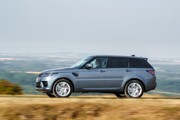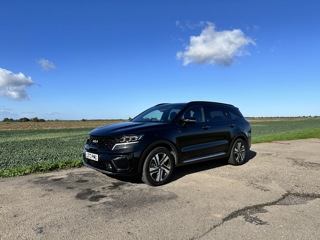Review
Land Rover's once diesel-heavy line-up has been transformed in recent years, with plug-in hybrid (PHEV) powertrains offered across all but one of its models today.
Its easy to see why. A diesel Range Rover Sport emits 237g/km of CO2, placing it in the 37% benefit-in-kind bracket, while the P400e puts out just 76g/km. This means it costs drivers around half as much in tax, while they also get to enjoy an extra 100PS in extra power.
The car utilises a four-cylinder turbocharged petrol engine, paired with an electric motor and 13.8kWh battery.
It promises a fully-electric range of up to 25 miles, although the system is set up to operate like a conventional hybrid - where the motor works in tandem with the engine.
With a charged battery, the P400e provides rapid acceleration, achieving a 0-60mph time of just 6.3 seconds.
Land Rover claims average fuel consumption of 77-83mpg (WLTP). During our testing, we found the car returns closer to 35mpg, although greater use of the battery on short journeys will improve this figure. On one longer run we managed 52mpg.
Drivers can select EV mode to force the P400e to run on battery power alone. We found a range of around 21 miles is possible before the car wants to switch over to petrol power.
The hybrid system is linked to the sat-nav and can adapt its use of the electric motor to support different types of journey. This might include saving battery power for the end of the trip, for example.
Surprisingly, fitting a four-cylinder engine to a two-and-a-half tonne Range Rover has done little to dampen its appeal. Pick-up is instant and rather aggressive, while more relaxed driving makes use of the electric motor’s silent operation.
The plug-in Range Rover Sport still retains its highly-regarded yet rarely optimised off-road ability.
Its Battery pack is stored underneath the boot floor so there is no spare wheel and a reduction in boot capacity by 76 litres, to 446 litres. It also means you can't spec the hybrid with seven-seats.
Charging the P400e takes less than three hours using a fast charger or seven on a three-pin household plug. The charging point is mounted behind a flap in the front grille, meaning you have to – annoyingly - park it front-first into spaces.
The Range Rover Sport P400e isn’t the only plug-in hybrid SUV on the market. There is the Volvo XC90 T8, which promises around 40-miles of emissions-free driving, and the BMW X5 45e, with a 50-plus mile range.
With running costs of 62p per mile, the Range Rover is not the best choice for fleets, the BMW takes that accolade.
However, with excellent road manners, a beautifully crafted interior and a sense of prestige that other manufacturers cannot match, the Range Rover Sport comes with desirability by the bucket load and is likely to be at the top of most (eligible) people’s wish list.
Specs
| Manufacturer | Land Rover |
| Model | Range Rover Sport |
| Specification | Range Rover Sport SUV 2.0 P400e PHEV 13.1kWh 404 SS HSE 5Seat Auto8 19MY |
| Model Year | 0.00 |
| Annual VED (Road tax) | £0 |
| BIK List Price | £72,115 |
| CO2 | 71g/km |
| BIK Percentage | 16% |
| Insurance Group | N/A |
| CC | N/A |
| Fuel Type | Petrol Hybrid |
| Vehicle Type | SUV and Crossover |
| Luggage capacity (Seats up) | 5litres |
Running Costs
| P11D | £72,115 |
| Insurance group | N/A |
| Fuel Type | Petrol Hybrid |
| Cost per mile | 161.45ppm |
| Fuel | 13.86ppm |
| Depreciation | 141.20ppm |
| Service maintenance and repair | 6.39ppm |
Rivals
Info at a glance
-
P11D Price
£72,115
-
MPG
91.1 -
CO2 Emissions
71g/km -
BIK %
16% -
Running cost
3 Year 60k : N/A 4 Year 80k : N/A -
Fuel Type
Petrol Hybrid


















 Petrol Hybrid
Petrol Hybrid

















